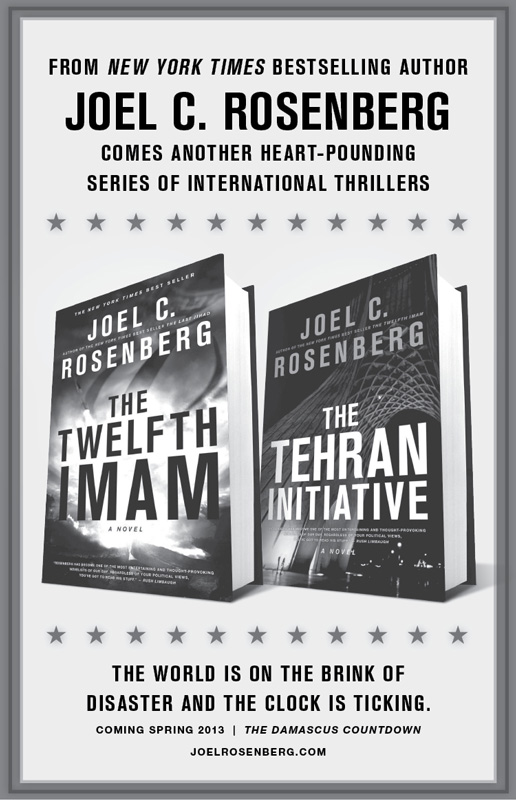Implosion (44 page)
Authors: Joel C. Rosenberg
Tags: #Religion, #Christian Life, #Social Issues, #RELIGION / Christian Life / Social Issues

[430]
John F. Kennedy, “Address to the Massachusetts General Court,” January 9, 1961, transcript and audio at John F. Kennedy Presidential Library and Museum,
http://www.jfklibrary.org/Asset-Viewer/OYhUZE2Qo0-ogdV7ok900A.aspx
; also see transcript at
http://www.americanrhetoric.com/speeches/jfkcommonwealthmass.htm
.
[431]
Ronald Reagan, “Farewell Address to the Nation,” January 11, 1989, transcript and video at Miller Center, University of Virginia,
http://millercenter.org/scripps/archive/speeches/detail/3418
.
[432]
Cited by William J. Federer,
America’s God and Country: Encyclopedia of Quotations
(Coppell, TX: Fame Publishing, 1994), p. 660.
[433]
Ibid., p. 12.
[434]
Ibid., p. 324.
[435]
Ibid., p. 323.
[436]
Cited by Tim LaHaye,
Faith of Our Founding Fathers
(Brentwood, TN: Wolgemuth & Hyatt Publishers, 1987), p. 127.
[437]
Cited by Walter Isaacson,
Benjamin Franklin: An American Life
(New York: Simon & Schuster, 2003), p. 30.
[438]
The rest of the citations came from Enlightenment sources, the Whigs, common law, classical literature, or other sources. Donald S. Lutz,
A Preface to American Political Theory
(Lawrence, KS: University Press of Kansas, 1992), pp. 134–135. Lutz cites a study he did several years earlier. See Donald S. Lutz, “The Relative Influence of European Writers on Late Eighteenth Century American Political Thought,”
American Political Science Review
78 (March 1984): 189–197.
[439]
See Thomas Jefferson et al., Declaration of Independence, July 4, 1776, transcription of the original document at the National Archives,
http://www.archives.gov/exhibits/charters/declaration_transcript.html
.
[440]
See the text of the United States Constitution at
http://www.archives.gov/exhibits/charters/constitution.html
and the Bill of Rights at
http://www.archives.gov/exhibits/charters/bill_of_rights.html
.
[441]
This number is cited here to describe a political reality, not a spiritual one. The number does not necessarily reflect how many Americans in 1976 truly understood the biblical meaning of the term
born again
found in John 3, believed every element of orthodox Christian teaching in the New Testament, and were fully devoted followers of Jesus Christ who had a personal relationship with him. Rather, it simply reflects a pollster asking a voter, “Do you consider yourself a born-again Christian?” and the voter saying yes. Also, it should be noted that these numbers (and those that follow in this section of the book) specifically refer to
white
born-again Christians, as this is the group the Gallup poll was tracking. See Albert L. Winseman, “‘Born-Agains’ Wield Political, Economic Influence,” Gallup commentary, April 13, 2004,
http://www.gallup.com/poll/11269/bornagains-wield-political-economic-influence.aspx
.
[442]
See Doug Wead, “The History of the Evangelical Vote in Presidential Elections,”
Doug Wead The Blog
, September 11, 2008,
http://dougwead.wordpress.com/2008/09/11/the-history-of-the-evangelical-vote-in-presidential-elections/
. Wead was a political advisor to Presidents George H. W. Bush and George W. Bush on evangelical political matters. He analyzed the numbers from numerous public and private exit polls, leaning most heavily on Gallup data.
[443]
The 39 percent figure comes from a December 7–10, 1979, poll. See Conrad Hackett and D. Michael Lindsay, “Measuring Evangelicalism: Consequences of Different Operationalization Strategies,”
Journal for the Scientific Study of Religion
47, (August 28, 2008): 502, Table 1, Gallup Poll Evangelical Questions.
[444]
See Sara Diamond,
Not by Politics Alone: The Enduring In
f
luence of the Christian Right
(New York: Guilford Press, 1998), p. 62; see also Wead, “History of the Evangelical Vote.” The
New York Times
reported Reagan winning 56 percent of the born-again vote to 40 percent for Carter. See “National Exit Polls Table,”
New York Times
, November 5, 2008,
http://elections.nytimes.com/2008/results/president/national-exit-polls.html
. The differences come from how pollsters define “born-again Christians,” including whether they only include Protestants or also include Catholics.
[445]
Wead.
[446]
Ibid.
[447]
Ibid. The Ross Perot numbers come from the
New York Times
exit polls.
See
“National Exit Polls Table,”
http://elections.nytimes.com/2008/results/president/national-exit-polls.html
.
[448]
“National Exit Polls Table.”
[449]
Winseman.
[450]
Wead.
[451]
Ibid.
[452]
In March 2008, polls showed Senator McCain was losing the Christian vote to an unnamed Democratic nominee (Barack Obama and Hillary Clinton were still battling for the nomination), 36 percent to 45 percent, with 19 percent of Christian voters undecided. Among Protestants, McCain pulled even with the Democrats at 40 percent. But the Democrats had a strong 32-point lead over McCain among Catholics. Among white evangelical Protestants, McCain was doing better (51 percent to 28 percent) but had certainly not rallied born-again voters behind him at that point. For an analysis of Senator McCain’s challenges among born-again Christians earlier in the campaign year, see Joel C. Rosenberg, “McCain’s Evangelical Problem,” National Review Online, March 26, 2008,
http://www.nationalreview.com/blogs/print/224034
. For final numbers, see “National Exit Polls Table,”
http://elections.nytimes.com/2008/results/president/national-exit-polls.html
.
[453]
See CNN’s national exit polls for the 2010 midterm congressional elections, posted online at “Exit Polls,” Election Center, CNN Politics,
http://www.cnn.com/ELECTION/2010/results/polls/#USH00p1
.
[454]
Winthrop.





